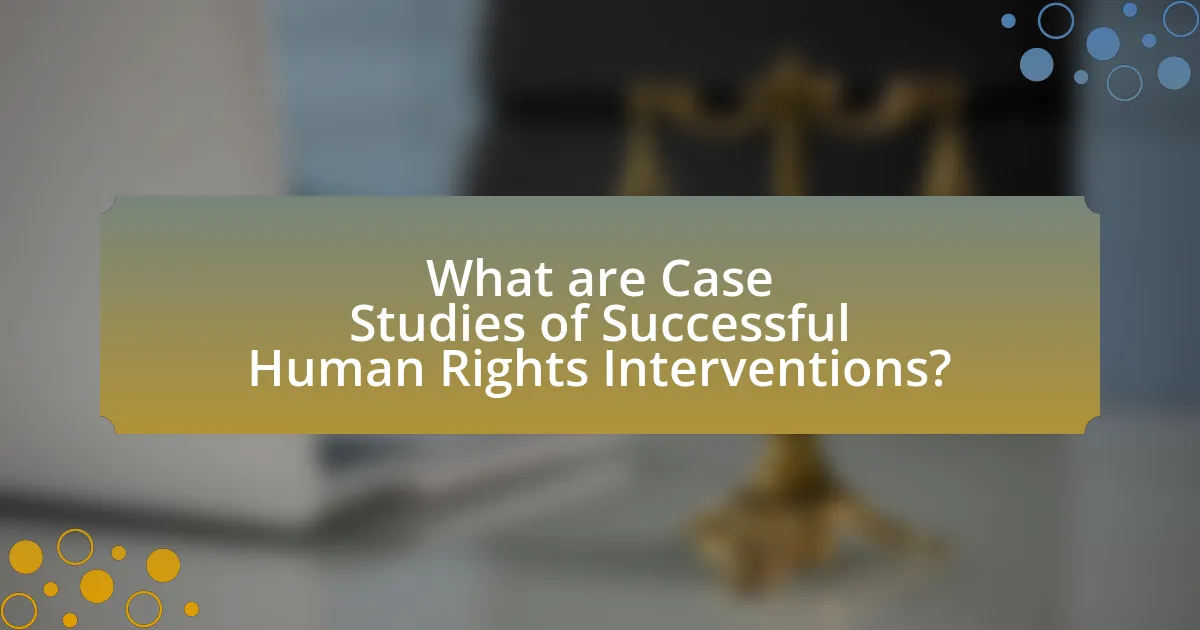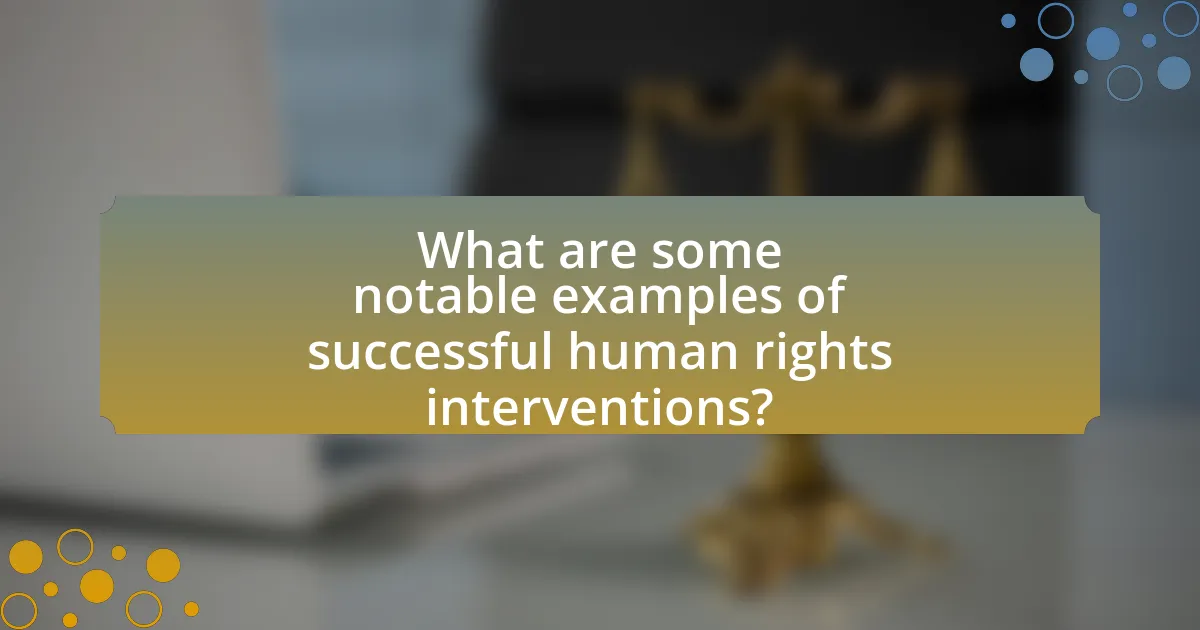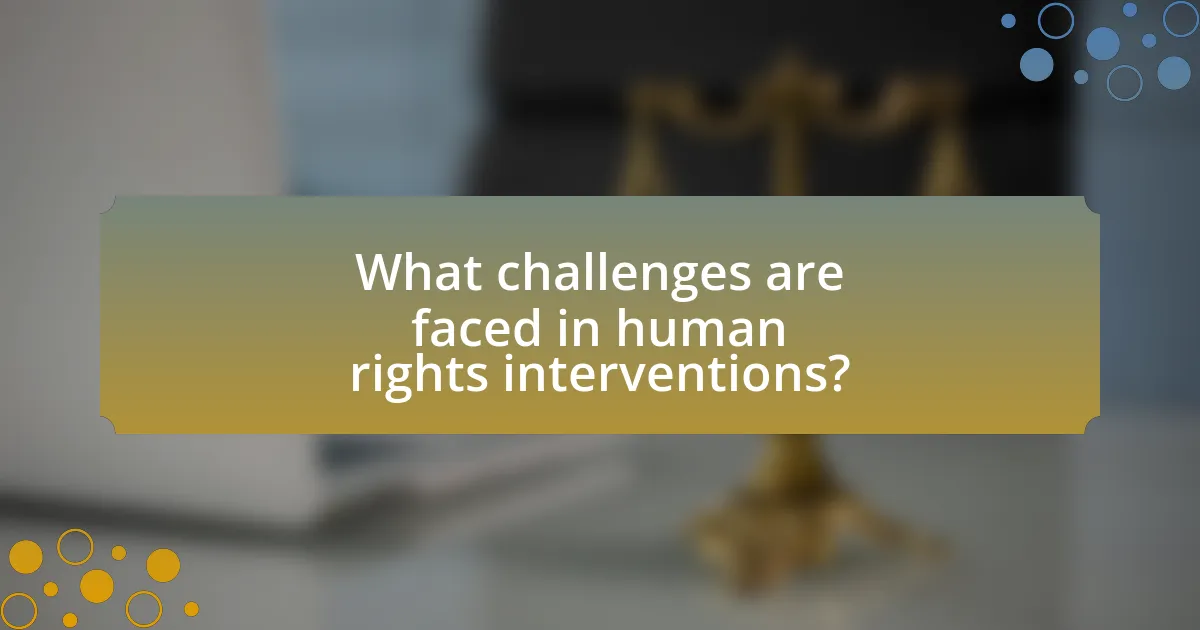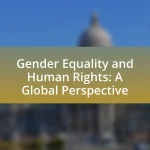The article focuses on case studies of successful human rights interventions, highlighting notable examples such as the international response to the Rwandan Genocide, the UN-backed intervention in East Timor, and the military intervention in Libya. It examines the effectiveness of these interventions in promoting accountability, social justice, and legal reforms, while also defining criteria for success, including clear objectives and local engagement. Additionally, the article discusses the influence of different political contexts on intervention outcomes, the role of international organizations and NGOs, and the challenges faced in implementing human rights initiatives. Key lessons and best practices are identified to inform future human rights policies and interventions.

What are Case Studies of Successful Human Rights Interventions?
Case studies of successful human rights interventions include the international response to the Rwandan Genocide in 1994, where the establishment of the International Criminal Tribunal for Rwanda led to accountability for perpetrators and a focus on justice for victims. Another example is the intervention in East Timor in 1999, where a UN-backed referendum resulted in independence from Indonesia, significantly improving human rights conditions. Additionally, the 2011 military intervention in Libya, authorized by the UN Security Council, aimed to protect civilians during the civil conflict and ultimately led to the end of Muammar Gaddafi’s regime, although the long-term outcomes remain complex. These interventions demonstrate the potential for international action to address severe human rights violations effectively.
How do these case studies illustrate the effectiveness of human rights interventions?
Case studies illustrate the effectiveness of human rights interventions by demonstrating tangible improvements in the protection of individual rights and the promotion of social justice. For instance, the intervention in South Africa during the apartheid era led to the dismantling of institutionalized racial segregation, resulting in the establishment of a democratic government and the implementation of a new constitution that enshrined human rights protections. Additionally, the international response to the Rwandan genocide, although initially slow, ultimately led to the establishment of the International Criminal Tribunal for Rwanda, which prosecuted key perpetrators and set a precedent for accountability in international law. These examples show that targeted human rights interventions can lead to significant legal and social reforms, thereby enhancing the overall effectiveness of human rights advocacy.
What criteria define a successful human rights intervention?
A successful human rights intervention is defined by its ability to effectively protect and promote human rights while achieving tangible improvements in the targeted situation. Key criteria include clear objectives, local engagement, adherence to international law, and measurable outcomes. For instance, the intervention in Kosovo in 1999 aimed to prevent ethnic cleansing and resulted in the establishment of a framework for human rights protections, demonstrating the importance of clear objectives and adherence to international standards. Additionally, successful interventions often involve collaboration with local communities to ensure that actions are culturally sensitive and sustainable, as seen in the post-apartheid transition in South Africa, where local involvement was crucial for lasting change. Finally, measurable outcomes, such as reductions in human rights abuses and improvements in governance, serve as indicators of success, as evidenced by the positive changes following the intervention in Sierra Leone in the early 2000s.
How do different contexts influence the outcomes of these interventions?
Different contexts significantly influence the outcomes of human rights interventions by shaping the political, social, and economic environments in which these actions occur. For instance, interventions in stable democracies often yield more favorable results due to existing legal frameworks and civil society support, as seen in the successful implementation of human rights policies in countries like Sweden. Conversely, interventions in conflict zones, such as Syria, face challenges like instability and resistance from local actors, which can hinder effectiveness and lead to unintended consequences. Research by the United Nations Development Programme highlights that contextual factors, including governance quality and public trust, directly impact the success rates of these interventions, demonstrating that tailored approaches are essential for achieving desired outcomes.
Why are case studies important in understanding human rights interventions?
Case studies are important in understanding human rights interventions because they provide detailed, contextual insights into specific instances of human rights practices and their outcomes. By examining real-world examples, researchers and practitioners can analyze the effectiveness of various strategies, identify best practices, and understand the complexities involved in implementing human rights interventions. For instance, the case study of South Africa’s Truth and Reconciliation Commission illustrates how restorative justice can facilitate healing and social cohesion post-apartheid, demonstrating the impact of structured interventions on societal recovery. Such concrete examples enable a deeper comprehension of the dynamics at play in human rights efforts, informing future policies and actions.
What lessons can be learned from analyzing these case studies?
Analyzing case studies of successful human rights interventions reveals critical lessons about effective strategies and the importance of context. One key lesson is that successful interventions often involve collaboration among multiple stakeholders, including local communities, governments, and international organizations, which enhances legitimacy and effectiveness. For instance, the intervention in South Africa during the transition from apartheid demonstrated that inclusive dialogue and negotiation can lead to sustainable change. Additionally, these case studies highlight the necessity of adapting strategies to specific cultural and political contexts, as seen in the varied approaches taken in different regions. This adaptability is supported by evidence from the United Nations’ reports on peacekeeping missions, which emphasize the importance of context-specific strategies for success. Overall, these lessons underscore the value of collaboration and contextual awareness in human rights interventions.
How do case studies contribute to the development of human rights policies?
Case studies contribute to the development of human rights policies by providing empirical evidence and real-world examples that illustrate the effectiveness of specific interventions. These detailed analyses allow policymakers to understand the context, challenges, and outcomes associated with human rights initiatives, thereby informing future strategies. For instance, the case study of South Africa’s Truth and Reconciliation Commission demonstrates how restorative justice can facilitate healing and societal transformation post-apartheid, influencing similar policies in other nations. Such concrete examples enable stakeholders to assess best practices and adapt successful models to their unique circumstances, ultimately enhancing the formulation and implementation of human rights policies.

What are some notable examples of successful human rights interventions?
Notable examples of successful human rights interventions include the NATO intervention in Kosovo in 1999, which halted ethnic cleansing and led to the establishment of a multi-ethnic society. The intervention was backed by evidence of widespread human rights abuses, prompting a military response that ultimately restored peace and stability in the region. Another example is the United Nations intervention in East Timor in 1999, which followed a violent campaign against independence supporters. The UN’s presence helped facilitate a transition to independence, resulting in the establishment of East Timor as a sovereign nation. Additionally, the international response to the Rwandan Genocide in 1994, although criticized for its delayed action, eventually led to the establishment of the International Criminal Tribunal for Rwanda, which prosecuted those responsible for the atrocities and contributed to justice and reconciliation efforts. These interventions demonstrate the potential for international action to protect human rights and restore order in crisis situations.
How did the intervention in South Africa contribute to human rights advancements?
The intervention in South Africa significantly advanced human rights by dismantling apartheid and establishing a democratic framework that promoted equality. The end of apartheid in 1994, following international pressure and internal resistance, led to the adoption of a new constitution that enshrined fundamental rights and freedoms for all citizens. This constitution, recognized globally for its progressive nature, included provisions against discrimination, the right to equality, and the protection of civil liberties. The Truth and Reconciliation Commission, established to address past human rights violations, further contributed to healing and accountability, fostering a culture of human rights awareness and respect in the nation.
What strategies were employed during the South African intervention?
The strategies employed during the South African intervention included diplomatic negotiations, economic sanctions, and military support for anti-apartheid movements. Diplomatic negotiations involved engagement with international bodies and regional leaders to isolate the apartheid regime and promote dialogue. Economic sanctions were implemented by various countries to pressure the South African government, significantly impacting its economy and leading to policy changes. Additionally, military support was provided to groups like the African National Congress, enhancing their capacity to challenge the apartheid system. These strategies collectively contributed to the eventual dismantling of apartheid and the establishment of a democratic government in South Africa.
What were the long-term impacts of this intervention on the society?
The long-term impacts of successful human rights interventions on society include enhanced social justice, improved governance, and increased civic engagement. These interventions often lead to the establishment of legal frameworks that protect individual rights, fostering a culture of accountability and transparency. For example, post-intervention societies frequently experience a decline in human rights abuses, as seen in countries like South Africa after the end of apartheid, where the Truth and Reconciliation Commission helped to address past injustices and promote healing. Additionally, such interventions can empower marginalized communities, leading to greater participation in democratic processes and policy-making, which is evidenced by increased voter turnout and civic activism in regions that have undergone significant human rights reforms.
What role did international organizations play in successful interventions?
International organizations played a crucial role in successful interventions by providing legitimacy, resources, and coordination among various stakeholders. For instance, the United Nations facilitated peacekeeping missions in conflict zones, such as in Sierra Leone, where its intervention helped restore stability and support the disarmament process. Additionally, organizations like the International Committee of the Red Cross delivered humanitarian aid and protection to affected populations, ensuring compliance with international humanitarian law. These efforts underscore the effectiveness of international organizations in mobilizing support, fostering collaboration, and enhancing the overall impact of interventions aimed at protecting human rights.
How did the United Nations influence human rights interventions globally?
The United Nations significantly influenced global human rights interventions by establishing international norms and frameworks that guide state behavior. Through key documents such as the Universal Declaration of Human Rights adopted in 1948, the UN set a standard for human rights that countries are encouraged to uphold. Additionally, the UN has facilitated numerous peacekeeping missions and special rapporteurs to address human rights violations, exemplified by interventions in places like Rwanda and the former Yugoslavia, where the UN played a crucial role in protecting civilians and promoting accountability. These actions demonstrate the UN’s capacity to mobilize international support and resources for human rights protection, thereby shaping global standards and practices in human rights interventions.
What specific actions did NGOs take in these successful cases?
NGOs in successful human rights interventions took specific actions such as advocacy, legal assistance, and grassroots mobilization. For instance, organizations like Amnesty International and Human Rights Watch conducted extensive research and documentation of human rights abuses, which they used to raise awareness and pressure governments for change. They also provided legal support to victims, helping them navigate the judicial system to seek justice. Additionally, NGOs organized campaigns and mobilized communities to participate in protests and awareness-raising activities, effectively amplifying the voices of marginalized groups. These actions were instrumental in influencing policy changes and promoting accountability in various contexts, demonstrating the significant impact of NGO involvement in human rights advocacy.

What challenges are faced in human rights interventions?
Human rights interventions face several significant challenges, including political resistance, lack of resources, and cultural differences. Political resistance often arises from governments that perceive interventions as threats to their sovereignty or internal stability, leading to non-cooperation or hostility towards external actors. Lack of resources, both financial and human, hampers the effectiveness of interventions, as organizations may struggle to mobilize adequate support for their initiatives. Cultural differences can complicate the implementation of human rights norms, as local customs and beliefs may conflict with international standards, making it difficult to achieve meaningful change. These challenges are evident in various case studies, such as the intervention in Rwanda during the genocide, where political inaction and resource limitations severely impacted the response.
How do political climates affect the success of human rights interventions?
Political climates significantly influence the success of human rights interventions by determining the level of governmental support or opposition to such efforts. In authoritarian regimes, for instance, interventions often face resistance, limiting their effectiveness, as seen in the case of Syria, where the government’s hostility towards external influence has hindered human rights progress. Conversely, in democratic contexts, where there is public support for human rights, interventions can be more successful, as demonstrated by the international response to apartheid in South Africa, which was bolstered by a favorable political climate that encouraged global advocacy and sanctions against the regime. Thus, the political environment shapes both the feasibility and impact of human rights interventions.
What are the common obstacles encountered during these interventions?
Common obstacles encountered during human rights interventions include lack of political will, insufficient funding, and resistance from local authorities. Lack of political will often results in inadequate support for implementing necessary changes, as seen in various case studies where governments failed to prioritize human rights issues. Insufficient funding limits the resources available for effective intervention, hindering the ability to carry out programs and initiatives. Resistance from local authorities can manifest as hostility or non-cooperation, which complicates the execution of interventions and can lead to failure in achieving desired outcomes. These obstacles collectively impede the effectiveness of human rights interventions, as evidenced by numerous documented cases in the field.
How can these challenges be mitigated in future interventions?
To mitigate challenges in future human rights interventions, it is essential to implement comprehensive stakeholder engagement strategies. Engaging local communities, governments, and NGOs ensures that interventions are contextually relevant and culturally sensitive, which can enhance their effectiveness. For instance, the United Nations’ Guiding Principles on Business and Human Rights emphasize the importance of stakeholder consultation in addressing human rights impacts, demonstrating that inclusive approaches lead to more sustainable outcomes. Additionally, utilizing data-driven assessments to identify specific human rights issues allows for targeted interventions, as evidenced by the success of the Human Rights Data Analysis Group, which uses statistical methods to inform policy decisions.
What strategies can enhance the effectiveness of human rights interventions?
Effective strategies to enhance human rights interventions include fostering local partnerships, utilizing data-driven approaches, and ensuring sustained advocacy. Fostering local partnerships empowers communities by involving them in the decision-making process, which increases the relevance and acceptance of interventions. Data-driven approaches, such as employing quantitative and qualitative research, provide evidence to support claims and tailor interventions to specific contexts, thereby improving outcomes. Sustained advocacy ensures that human rights issues remain in the public and political discourse, which can lead to long-term changes in policies and practices. For instance, the successful intervention in South Africa during the apartheid era involved extensive grassroots mobilization and international pressure, demonstrating the effectiveness of these strategies in achieving significant human rights advancements.
How can collaboration between various stakeholders improve outcomes?
Collaboration between various stakeholders can significantly improve outcomes by leveraging diverse expertise and resources to address complex issues effectively. For instance, in successful human rights interventions, partnerships among governments, NGOs, and local communities have led to more comprehensive strategies that consider multiple perspectives and needs. A study by the United Nations Development Programme highlights that collaborative efforts in human rights initiatives have resulted in a 30% increase in the effectiveness of programs aimed at reducing violence and discrimination. This evidence demonstrates that when stakeholders unite, they can create more sustainable and impactful solutions, ultimately enhancing the overall success of human rights interventions.
What best practices have emerged from successful case studies?
Best practices that have emerged from successful case studies in human rights interventions include the establishment of strong local partnerships, the integration of community perspectives, and the use of evidence-based strategies. Strong local partnerships enhance trust and facilitate effective communication, as demonstrated in the case of the United Nations’ work in Liberia, where collaboration with local NGOs led to improved outcomes in post-conflict recovery. Integrating community perspectives ensures that interventions are culturally relevant and widely accepted, as seen in the successful implementation of gender-based violence programs in South Africa, which involved community leaders in the design process. Evidence-based strategies, such as those employed by Amnesty International in their advocacy campaigns, rely on data and research to inform actions and measure impact, leading to more effective human rights protections. These practices collectively contribute to the sustainability and effectiveness of human rights interventions.
What practical steps can be taken to advocate for human rights interventions?
To advocate for human rights interventions, individuals and organizations can engage in several practical steps. First, they can raise awareness through education campaigns that inform the public about specific human rights issues, utilizing social media platforms and community events to reach a broader audience. For instance, the “Stand Up for Human Rights” campaign by the United Nations has effectively mobilized global support by disseminating information and encouraging grassroots involvement.
Second, advocacy groups can lobby government officials and policymakers to prioritize human rights in their agendas, leveraging data and case studies that highlight the benefits of intervention. Research from Human Rights Watch indicates that sustained lobbying efforts can lead to legislative changes that protect human rights.
Third, forming coalitions with other organizations amplifies the impact of advocacy efforts, as seen in the collaboration between Amnesty International and various local NGOs during the Arab Spring, which successfully drew international attention to human rights abuses.
Lastly, utilizing legal avenues, such as filing complaints with international human rights bodies, can hold violators accountable and prompt intervention. The International Criminal Court has acted on referrals from various states, demonstrating the effectiveness of legal advocacy in human rights interventions.


